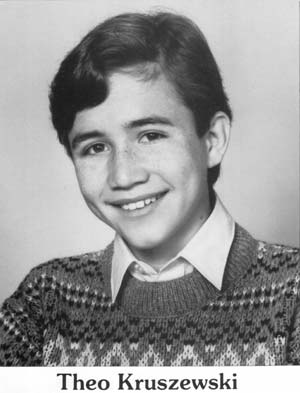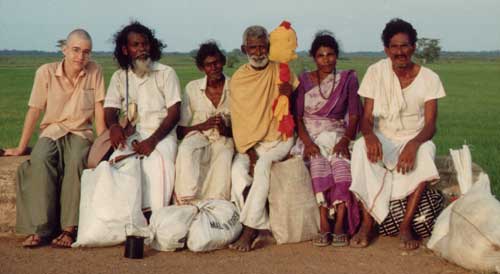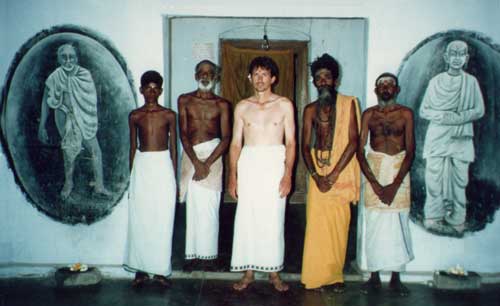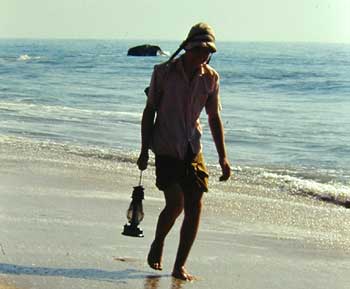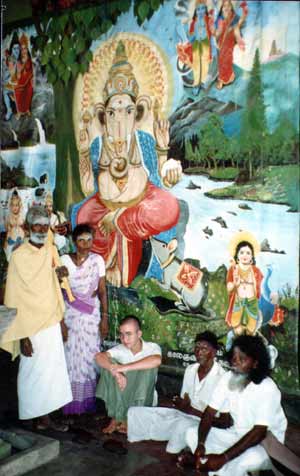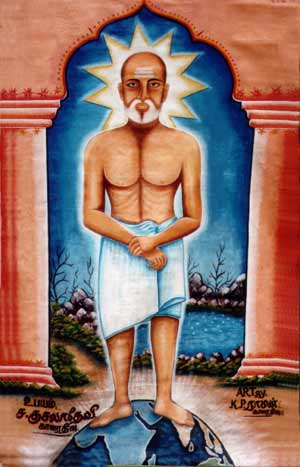|
| |||||||||||||||

Theo's Adventures in Alternative LankaEpisode III: "In the Footsteps of the Siddhas"as recorded by Patrick HarriganIn this age of mechanized transport, few but the most dedicated of religious pilgrims arrive at their goal any longer by literally walking in the footsteps of those who walked before them. And now in the age of the digital age with its gigabytes of instant information, few experts have time any longer to winnow out for themselves the odd shards of wisdom—the crown jewels dumped together with the family garbage — that lie waiting for patient investigators to re-discover. But at last a few have begun to take notice of the fabulous possibilities. For fifteen-year old Theo Kruszewski, a model American teenager who came to Sri Lanka for his summer holidays to take part in ongoing research into the island's rich alternative culture, and for myself as well, the ‘foolishness' of Sri Lanka's living tradition of pāda yātrā or foot pilgrimage is serious business. For by joining with the simple unlettered custodians of the Tradition in their ritual passage from Trincomalee to Kataragama, we hoped to gather fresh clues concerning the possible survival ‘underground' of Kataragama's legendary mystery schools. Relying more upon the topsy-turvy 'wisdom of the foolish' than upon the conventional wisdom of modern-educated circles, Theo and I donned out simple pilgrims' garb and set out one June morning in 1991 in the company of a small kūttam or party of Tamil devotees daring enough to entrust their lives to the surety of their god's invisible protecting hand. Armed with just a small camera, we were determined to follow them all the way to Kataragama.
"To know the tradition, you must follow the tradition", says an ancient dictum. To us as next-generation researchers, this rule meant that we were to participate directly and be a part of the tradition instead of remaining apart from it. By earning the confidence of key informants, we hoped to gain access to vital information that more learned scholars than us had overlooked. Our path to Kataragama—by no means easy to follow—would coincide with that of uncounted thousands of pilgrims of different religions who had passed before us, including many unrecognized saints and sages. Some, like the jnānis or ‘knowers' and the siddhas or ‘graduates' who had completed their course of discipline, are widely reputed to have had miraculous abilities or siddhis that are far beyond all but the imagination of lesser mortals. Even angels and gods like war god Skanda himself are said to have followed this ancient route in human guise. What reality, if any, is there behind the Kataragama legends? Is the path of the siddhas altogether imaginary, or has it been sealed, or has it only been concealed for reasons no one can fathom? Most especially, could people like us still gain entry today through diligence and luck to the Tradition's dazzling stairway to higher realms? These were the kinds of questions that weighed in the back of my mind and Theo's even as our miniature landing party of cinna alkal or ‘little people' disembarked for shore at Mutur on the far side of Trincomalee Bay. Our party of seven, the Vēl Kuttam, would have appeared as a motley collection of poor villagers and strange foreigners speaking in different tongues but all walking together as a group towards Kataragama for anyone who was watching. To many townspeople, we were a curious, puzzling sight: a mixed act of local and imported beggar-pilgrims, possibly walking to Kataragama at the worst possible time for sensible-minded people. But villagers all along the way recognized us for what we were, receiving us everywhere with courtesy and traditional hospitality. Even security forces and insurgents gave us their unstinting support once they understood what it was that we were trying to do. Following the coastal road southwards, our path took us past dozens of security checkposts, from settled towns to rich farming land and further to war-scarred expanses of empty fields and abandoned villages, in which hardly a single building was still standing intact. For three weeks, each day presented different challenges and ever-changing vistas amidst villages and long stretches of thick dry jungle where uncannily weathered rocks stand as lonely sentinels.
Almost daily, there were close brushes with disaster or death. Would suspicious insurgents believe our story, or would we be dragged off for interrogation and summary execution? Would trigger-happy village security units mistake our ragtag band for a guerrilla band and open fire upon us? No one said that it couldn't happen. But finally, once researchers and pilgrims alike had learned to place their trust in a higher power and keep it there, all troubles vanished. And yet, even in times of peace the Pada Yatra is a risky undertaking, as so many had discovered before us. Its routed is lined with the marked and unmarked graves of pilgrims who set out for Kataragama and passed out of this world in the process. To die en route, in fact, is considered to be a blessing of sorts. Among other dangers real or imagined was the ever-present concern that we might stumble upon some stray Johnny-mine or unseen trip-wire. We knew that, if we were really probing the defenses of the dreaded war god's last redoubt, then anything could happen. Any researchers, therefore, would have to bypass Kataragama's internal alarm system, let alone its formidable array of booby traps and automatic defenses against unwanted intruders. The safest approach, approach, is to go as pilgrims and to act naturally. "At first I thought that some dangers must be real and others only imaginary", recalls Theo. "Later I realized that the feeling of danger is just a feeling, and so every danger is the same." "Just like in a bad dream, bad things happen because we believe in them. Stop believing in a bad dream and – poof! – it goes away. But just try it sometime if you think it's that easy."
"Watching my own mind and studying the tricks that we all love to play on ourselves: that was the real exercise. But following that they're up to and what they're saying is even harder." Employing terse aphorisms like summa iru (‘Be still!', a standing order) or ellam avar ceyyal (‘All is His doing', our Vel Kuttam's motto), the Pada Yatra pilgrims do not simply endure whatever comes, but actually re-order their reading of events to conform with common sayings that are pregnant with wisdom. This, combined with the sustained festivity, alternative role-playing and other factors, actually and incredibly seems to alter objective reality for those who approach Kataragama in a sympathetic spirit, Not surprisingly, many of the rules or aphorisms governing Kataragama's mystery traditions have been handed down from generation to generation in the form of pithy sayings that serve to brighten the way of all who venture to undertake the perilous inward passage to the garden of peace and happiness in the heart of Deviange Kaele or 'God's Own Forest'. Seen from the jñāni's perspective, in that world there are no problems at all (Tamil: Oru pollappum illai) even when things look totally chaotic at the ground level. During the period of ritual pilgrimage, participants consciously step into an alternative vision of reality that is dramatically different from our own and yet remarkably similar. Its topsy-turvy logic (example: "the worse, the better") also displays the same qualities of paradox and play that characterize accounts of Kataragama. Could this mirroring or inverting process represent the key that might some day unlock for researchers the mysteries of alternative Lanka? Only time and more research will tell. Employing the buddy system, Theo and I took turns seeing how far we could plunge into the deep waters of Sri Lankan mystery tradition and still return safely. To what extent to reach and explore the parallel world or Kingdom of Kataragama and if possible, to return with as much information as possible to share with others like us. "The siddhas and jñānis must have been onto something that is out of this world. I mean, really fantastic. We didn't see any, but we met people who did", Theo later recalled. Our small party of pilgrims encountered a number of remarkable people whose lives had received a quickening touch as it were form contact with reputed jñānis and siddhas in living memory. At Sitthanaikutti Samadhi in Ampara district, for example, we met disciples of a modern siddha who was once seen walking upon the ocean in broad daylight, far out to sea. "Sitthanaikutti Swami must have been a real character", muses Theo who met the siddha's living disciples and watched them in action, acting and singing in spontaneous verse, often in duets. "I'm an actor myself, but nothing like these people. They must have got a terrific push from the old man. I'd like to know how." One aspect of the siddha legacy that exited our interest is their apparent mastery of the sleeping, dreaming, and waking states into a single integrated experience of unbounded unity. As masters of dreaming, they were capable of remaining awake and fully aware even as their dreams were in progress. This is called ‘lucid dreaming' in the language of current scientific parlance research. Some siddhas like Sitthanaikutti Swami had mastered themselves, it seems, to the extent that they could fly at the speed of thought, walk upon water or through mountains, tunnel across to other parallel dream-worlds and so on, but always within a framework of certain rules or principles. Scientists at Stanford University's Center for Sleep Research in California and elsewhere around the world are busily investigating such possibilities, which they regard as being no joke. Perhaps, Sri Lanka can provide clues. Walking by day and sleeping under the open sky by night, Theo and I wondered if we might be fortunate enough to see Kataragama the easy way—by dreaming ourselves there. Nothing so advanced happened to us while dreaming, but during waking hours we found it easy to exercise our imagination and wonder if we were really waking or dreaming. Studying our experiences in this light, we were deeply impressed by the rainbow-effect of human consciousness separating into diverse hues or shades of colour and meaning. Whatever the extent of our theoretical know-how of Pada Yatra, still there was no avoiding the moment-to-moment task of following the swamis and ammas of Vel Kuttam. Carrying a few essentials with us as we walked day after day under the fierce tropical sun, often hungry and thirsty, and nursing heat blisters on our tender feet, we adjusted ourselves to eating and drinking only when the whole party ate and drank, resting where they rested and moving at the same speed at which they moved. It was not easy. Taking our queues from the experienced villagers who were our hosts and guides, in time Theo and I, despite being foreigners, came to be accepted as legitimate pilgrims like all the rest. To do this, however, required that we remain patient, flexible and receptive in our hearts to the pilgrims' own ways of understanding. Using our wits as much as our feet, we learned to face every challenging situation and even to turn apparent adversity to our own advantage. And even at a tender age, young Theo learned to follow the finer points of a great oriental tradition. The Greater Mysteries of Kataragama, however, still lie before us. NEXT: Adventures in Kataragama's Enchanted Forest Part Two of Theo's Adventures in Alternative LankaPatrick Harrigan is acting editor of the Kataragama Research Publications Project. This article was written as Part III of a series that first appeared in "The Sunday Island" (Colombo) of 30 September 1991. Theo's summer in Sri Lanka was sponsored by the Kataragama Devotees Trust and Cultural Survival of Sri Lanka. Visit Theo Kruszewski's own website www.bingregory.com. |
|
